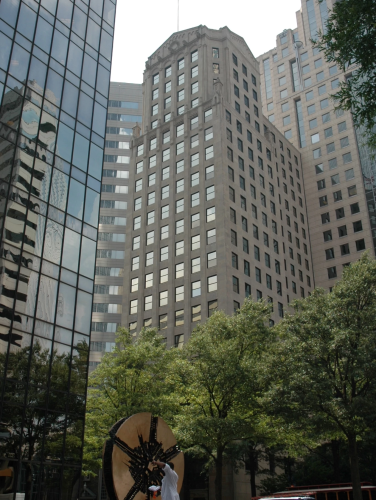
First National Bank
(ca. 1927)
Once the tallest building in the Carolinas, the Louis Asbury-designed First National Bank building housed the South’s first post-Civil War national bank.
110 and 112 S. Tryon St., Charlotte, NC 28202
The twenty-story First National Bank building is the tallest and one of the most prominent pre-World War II buildings in Charlotte. When completed in 1927, it was the tallest building in the Carolinas and remained the city’s tallest building for forty years. The building largely resulted from the efforts of two men, industrialist Henry M. McAden (1872-1957), the president of the bank from 1907 until its 1930 closing, and Louis H. Asbury (1877-1975), arguably Charlotte’s most prominent and important architect of the early twentieth century. The now defunct First National Bank of Charlotte, established in 1865 by New York-born Charlottean John Wilkes (1827-1908), contributed significantly to the city’s phenomenal economic success during the late nineteenth century.
Property Quick Links
During the Civil War, Wilkes served in the Home Guard in Charlotte, and his Mecklenburg Flour Mills was a chief supplier for the Army of Northern Virginia. After signing over ownership of the Mecklenburg Iron Works (which he purchased in 1858) to the Confederate Government, he and his brother Edmond directed wartime railroad construction in the South. Following the war and a presidential pardon, John Wilkes received a charter for the First National Bank of Charlotte, the first national bank in the post-war South and the first North Carolina bank to receive a charter to print national bank notes. Rufus Y. McAden (1833-1889) – Speaker of the North Carolina House and subsequent founder of Gaston County’s McAden Mills and adjacent mill village of McAdenville – assumed the presidency of the bank in 1867. The bank promoted his son Henry M. McAden to that same position in 1907. Already the president of the Piedmont Fire Insurance Company, Henry also succeeded his father as owner of McAden Mills.
Asbury, a Charlotte native and one of North Carolina’s first professionally trained architects, had already designed Henry McAden’s Myers Park home in 1916 when McAden commissioned him in 1925 to design the bank’s new skyscraper, to be located on the same site as the bank’s original three-story building. As an M.I.T graduate and North Carolina’s first member of the American Institute of Architects, Asbury earned hundreds of commissions in Charlotte and the surrounding counties, including the Mecklenburg County Courthouse, Mayfair Manor (renamed Dunhill Hotel), and Myers Park Methodist Church.
Completed at an estimated cost of $1.8 million, the First National Bank building proved unprofitable in large part due to McAden’s reluctance to lease space to “undesirable” tenants (including Southern Bell Telephone and Telegraph Company; McAden did not want their linesmen in and out of his new office building). Although the building did house the Charlotte branch of the Federal Reserve, the combination of the Great Depression and the building’s continued low occupancy rate (only 30% as of late 1930) forced the bank to close its doors for good on December 4, 1930. Subsequent anchor tenants included Liberty Life Insurance Company and Bank of North Carolina. Thanks to renovations in 1964 and 1982, the First National Bank building continues to thrive as a uniquely historical commercial hub within Charlotte’s business district.

